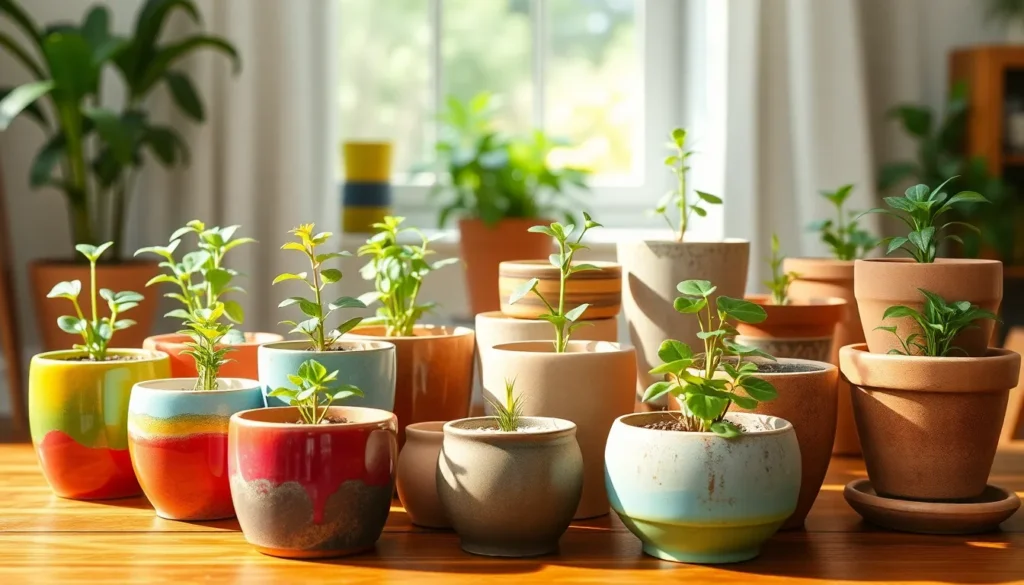Transform your indoor garden with the timeless elegance of ceramic plant pots. We’ve discovered that choosing the right container can make or break your plant’s health and your home’s aesthetic appeal. Ceramic pots aren’t just beautiful decorative pieces – they’re functional powerhouses that provide superior drainage breathability and temperature regulation for thriving plants.
Why ceramic outperforms plastic and terracotta becomes clear when you consider durability style options and plant health benefits. We’ll explore how these versatile containers work with everything from succulents to houseplants while adding sophisticated charm to any space.
Ready to elevate your plant game? We’re diving deep into ceramic pot selection sizing drainage considerations and styling tips that’ll transform your green space into an Instagram-worthy oasis. Whether you’re a beginner plant parent or seasoned gardener our comprehensive guide covers everything you need to make informed decisions about ceramic planters.
Top Benefits of Choosing Ceramic Pots for Plants
Ceramic pots offer distinct advantages that make them an excellent investment for indoor gardening enthusiasts. We’ve identified three key benefits that set ceramic planters apart from other container options.
Superior Drainage and Aeration
Drainage becomes significantly more effective with ceramic pots due to their porous nature and well-designed drainage holes. Water moves freely through the material, preventing root rot and other moisture-related plant diseases that commonly affect indoor gardens.
Aeration improves naturally as ceramic allows air to circulate around root systems more efficiently than plastic alternatives. The breathable walls help roots access oxygen while releasing excess carbon dioxide, creating an optimal growing environment for most houseplants.
Root health flourishes when plants receive proper drainage and airflow through ceramic containers. We’ve observed that plants in ceramic pots develop stronger, more extensive root systems compared to those in non-porous materials like glazed plastic or metal containers.
Temperature Regulation Properties
Temperature stability becomes more consistent with ceramic pots as they provide excellent insulation against rapid temperature fluctuations. The thick walls protect plant roots from sudden heat changes that can stress or damage delicate root systems.
Cooling effects occur naturally during hot weather as moisture evaporates through the ceramic walls, creating a microclimate around the plant. This evaporation process helps maintain optimal soil temperatures even when indoor temperatures rise above comfortable levels.
Heat retention works effectively during cooler periods, as ceramic material slowly releases stored warmth throughout the day. We find this thermal mass particularly beneficial for tropical plants that prefer consistent temperatures year-round.
Durability and Longevity
Construction quality in ceramic pots typically surpasses that of plastic or lightweight alternatives, making them a long-term investment for serious gardeners. High-fired ceramic resists cracking, fading, and deterioration even with regular watering and outdoor exposure.
Weight stability prevents tipping and provides a secure base for larger plants that might become top-heavy in lighter containers. The substantial mass of ceramic pots ensures tall plants remain upright without additional support structures.
Weather resistance allows ceramic pots to withstand seasonal changes when used for patio or balcony gardening. We’ve seen quality ceramic planters maintain their structural integrity and appearance for decades with proper care and handling.
Essential Types of Ceramic Pots for Plants
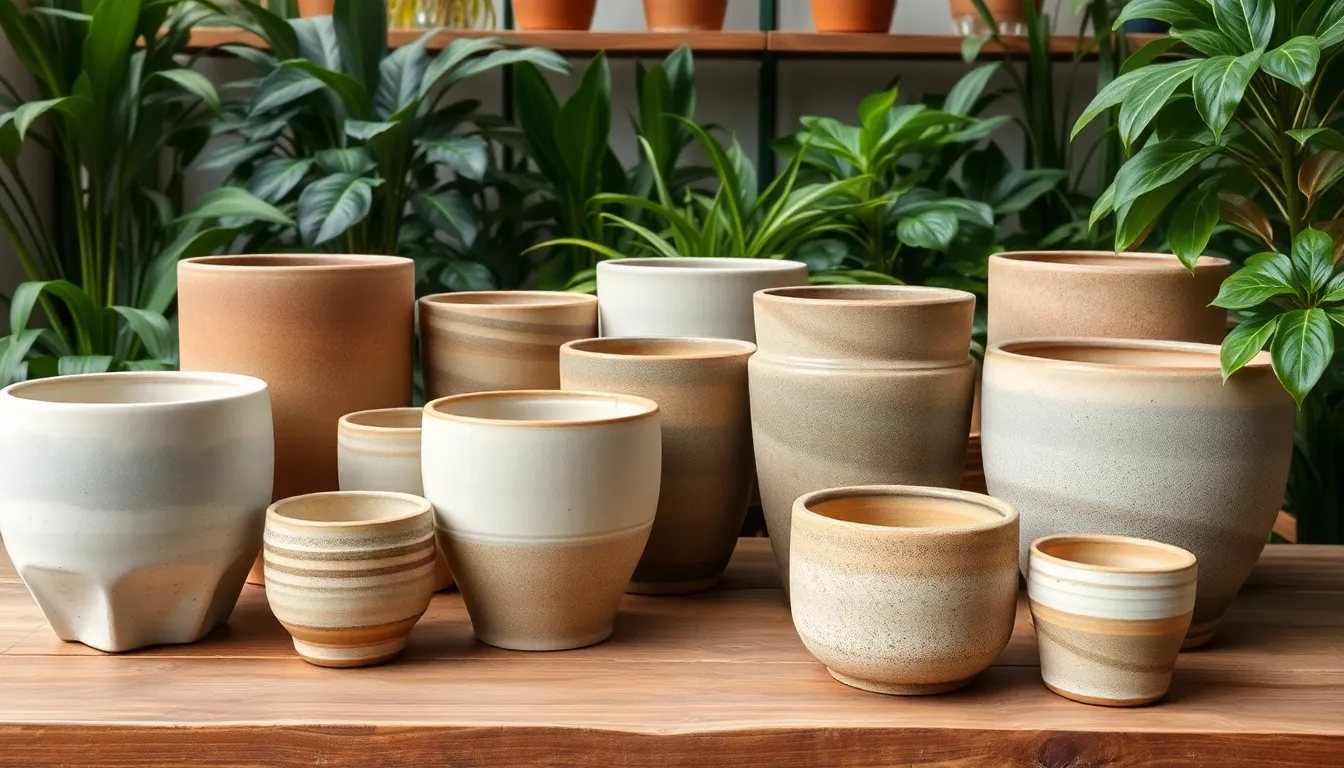
Ceramic planters come in several distinct varieties, each offering unique benefits for different plants and growing conditions. We’ll explore the three main types that every plant enthusiast should consider for their indoor garden.
Glazed Ceramic Planters
Glazed ceramic pots feature a smooth, colorful coating that creates a less porous surface compared to their unglazed counterparts. This protective glaze significantly reduces evaporation, helping retain moisture in the soil for extended periods. Plants that thrive in consistently moist conditions, such as ferns and tropical houseplants, benefit greatly from this moisture retention capability.
The glazing process limits airflow through the pot walls, but these containers still provide adequate support for healthy plant growth by maintaining stable moisture levels. Their varied designs and finishes make them an excellent choice for interior decor, allowing us to seamlessly blend function with style in our living spaces.
Unglazed Terra Cotta Options
Unglazed ceramic pots showcase natural porosity that allows both air and moisture to pass freely through the walls. This breathable quality promotes excellent airflow around root systems and facilitates natural water absorption from the surrounding environment. Root rot and overwatering issues become less problematic when using these porous containers.
These pots naturally wick excess moisture away from the soil, making them perfect for plants that prefer drier conditions or for gardeners who tend to water too frequently. Their classic earthy appearance complements both indoor and outdoor settings, providing a timeless aesthetic that never goes out of style.
Decorative Ceramic Containers
Decorative ceramic containers combine artistic design with practical functionality, offering plant enthusiasts the best of both worlds. Crafted through manual or mechanical processes, these pots showcase modern and artistic designs that surpass plastic or metal alternatives in visual appeal. Their heavier weight provides excellent stability for top heavy plants while preventing accidental tipping.
Thicker walls in decorative ceramic containers offer superior protection against extreme temperature fluctuations, helping maintain consistent root zone temperatures. This temperature regulation capability, combined with their eco friendly nature, makes them an ideal choice for serious plant collectors who value both aesthetics and plant health.
Key Features to Look for in Ceramic Pots for Plants
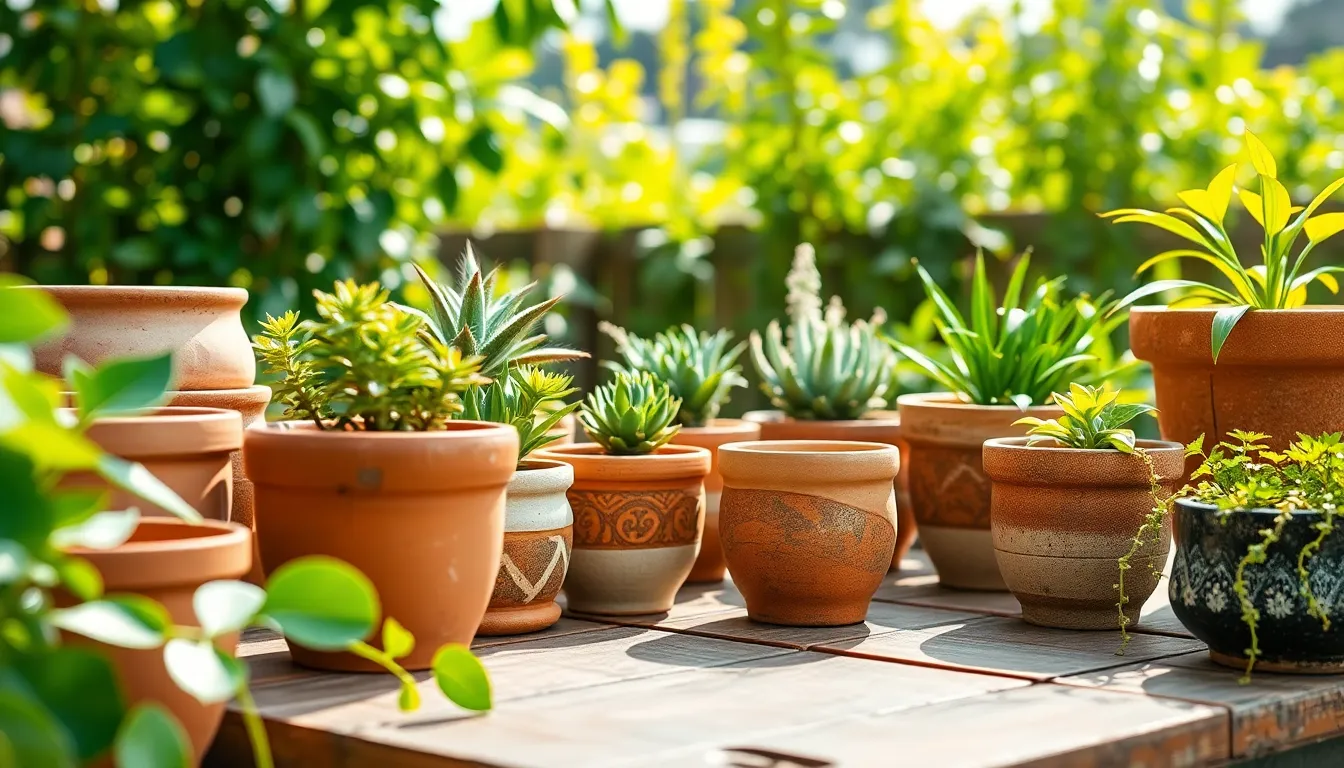
Selecting the right ceramic pot involves evaluating several critical features that directly impact your plant’s health and growth. We’ll examine the most important characteristics that separate exceptional ceramic planters from ordinary ones.
Proper Drainage Hole Placement
Drainage holes prevent waterlogging and root rot by allowing excess water to escape from ceramic containers. Well-positioned drainage holes enable air circulation around root systems while maintaining optimal moisture levels in the soil. We recommend choosing ceramic pots with at least one properly sized hole at the bottom center, as ceramic materials naturally retain moisture more effectively than other pot types.
Effective drainage becomes even more crucial with ceramic planters because they can accumulate water without proper outlets. Multiple smaller holes often work better than one large opening, distributing water flow evenly across the pot’s base. Strategic hole placement also prevents soil from washing out while ensuring adequate water release during regular watering routines.
Appropriate Size and Depth
Size selection directly impacts root development and overall plant health in ceramic containers. We suggest choosing pots that provide 1-2 inches of extra space around your plant’s current root ball, allowing room for growth without creating excessive soil volume. Deeper ceramic pots accommodate plants with longer tap roots like herbs and vegetables, while wider containers suit spreading root systems found in flowering plants and succulents.
Proportional sizing maintains proper soil moisture balance and prevents both overwatering and underwatering issues. Oversized ceramic pots retain too much moisture around smaller root systems, potentially causing fungal problems and stunted growth. Undersized containers restrict root expansion and require more frequent watering, limiting your plant’s potential development.
Quality of Ceramic Material
High-quality ceramic materials determine your pot’s durability, breathability, and moisture management capabilities. Unglazed ceramic pots offer superior air and moisture movement through pot walls, promoting healthy root aeration and preventing rapid soil drying. We prefer porous ceramic materials that naturally wick excess moisture while maintaining consistent soil conditions for optimal plant growth.
Premium ceramic construction withstands temperature fluctuations and environmental stress better than lower-grade alternatives. Quality ceramic pots maintain their structural integrity through seasonal changes and resist cracking from freeze-thaw cycles. Investing in well-fired ceramic planters ensures long-term performance and protects your plants from sudden temperature variations that could damage sensitive root systems.
Best Ceramic Pots for Plants by Room
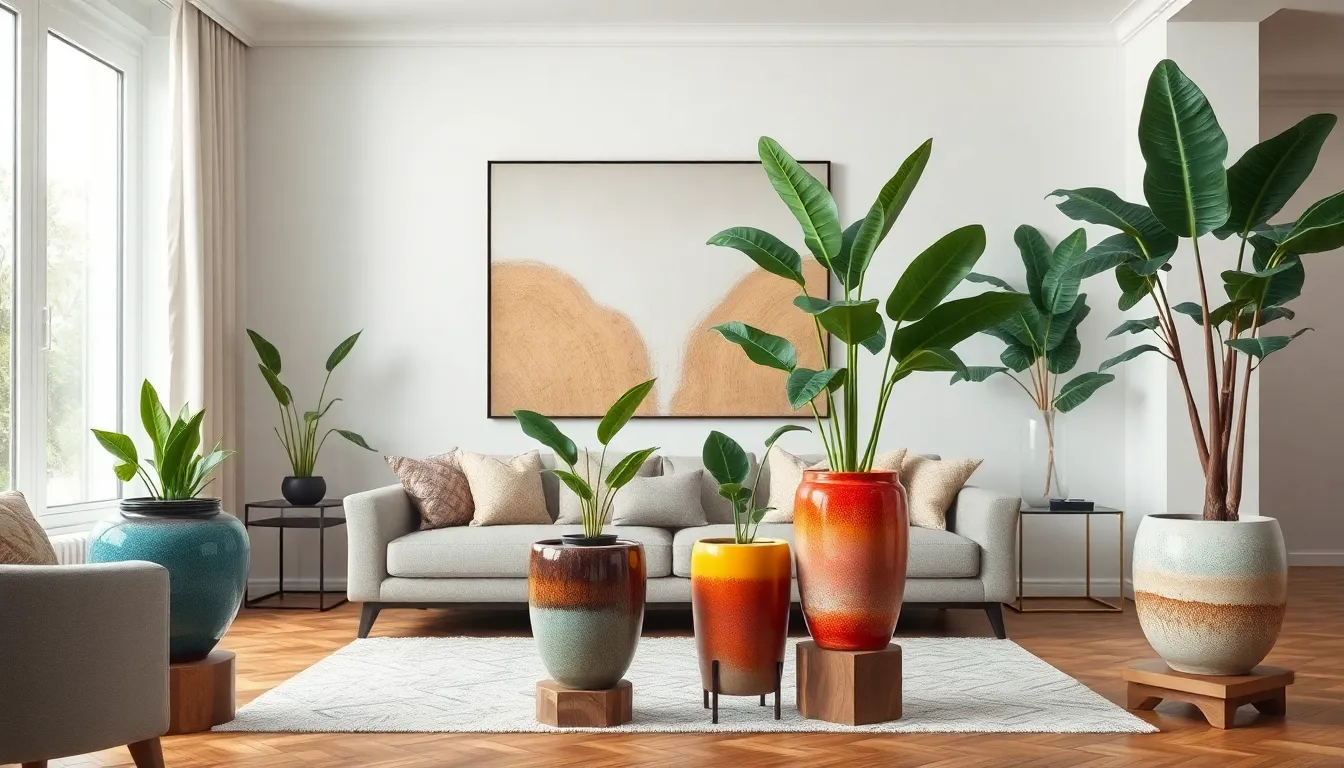
Choosing the right ceramic pot depends on your exact room environment and plant needs. We’ll explore how to select the perfect ceramic planters for different living spaces.
Living Room Statement Pieces
Modern ceramic pots transform living rooms into sophisticated plant sanctuaries that showcase your style. We recommend cylindrical ceramic planters with minimalist wooden bases that combine natural materials for contemporary appeal. These statement pieces work best in neutral or vibrant glazes that complement your existing décor.
Sleek geometric shapes create visual interest without overwhelming your furniture arrangement. Large ceramic containers serve as focal points for tall plants like fiddle leaf figs or rubber trees. Built-in drainage holes ensure your statement plants stay healthy while maintaining the pot’s elegant appearance.
Glazed finishes in matte or glossy textures add depth to your living space design. We suggest choosing ceramic pots that match your room’s color palette for seamless integration. Premium ceramic materials resist fading and cracking, making them long-term investments for your home décor.
Kitchen Herb Garden Containers
Medium-sized ceramic pots excel in kitchen herb gardens due to their natural moisture regulation properties. We find that the porous ceramic material helps maintain optimal growing conditions for culinary herbs like basil, thyme, and parsley. These containers fit perfectly on windowsills or countertops where herbs receive adequate sunlight.
Drainage holes in ceramic herb containers prevent waterlogging that can kill delicate herb plants. Neutral or rustic glazes complement both farmhouse and modern kitchen aesthetics seamlessly. The ceramic’s temperature stability protects herb roots from kitchen heat fluctuations near stoves or ovens.
Compact ceramic planters maximize limited kitchen counter space while providing sufficient room for herb root systems. We recommend choosing lighter-colored ceramics that reflect kitchen lighting and create a fresh, clean appearance. Multiple small ceramic pots allow you to grow different herbs while maintaining easy access for cooking.
Bathroom Humidity-Loving Plants
Glazed ceramic pots thrive in bathroom environments where high humidity levels benefit moisture-loving plants. We’ve found that ferns and peace lilies flourish in ceramic containers placed in bathrooms with adequate indirect light. The ceramic material retains soil moisture without creating waterlogged conditions that harm plant roots.
Moisture-resistant glazed finishes prevent damage from bathroom humidity and steam exposure. Ceramic pots maintain their appearance and structural integrity even though constant moisture fluctuations. We suggest selecting ceramic planters with excellent drainage to balance the bathroom’s natural humidity with proper soil aeration.
Non-porous glazed surfaces resist mold and mildew growth that can occur in humid bathroom conditions. Dark or neutral ceramic finishes hide water spots and complement bathroom fixtures effectively. These specialized ceramic containers create spa-like atmospheres while supporting healthy plant growth in challenging humid environments.
Top Ceramic Pot Styles for Different Plant Types

Different plants have unique requirements for root space, drainage, and soil conditions. We’ll explore the best ceramic pot styles designed to meet these exact growing needs.
Succulent-Friendly Shallow Pots
Shallow ceramic pots create the perfect environment for succulents by allowing quick drainage and reducing moisture retention. These plants prefer drier conditions to avoid root rot, making shallow designs ideal for their growth patterns. Unglazed ceramic options provide superior airflow through their porous nature, which succulents particularly benefit from for healthy root development.
Glazed ceramic pots work well for succulents when you need some moisture retention, though they’re typically less porous than unglazed versions. We recommend choosing shallow pots that are wider than they are deep, giving succulent roots room to spread horizontally. The natural porosity of ceramic material helps prevent the waterlogged conditions that can quickly kill these drought-loving plants.
Deep Pots for Root Vegetables
Root vegetables require substantial downward growing space, making deep ceramic containers essential for their success. These plants need room for their roots to develop vertically, whether you’re growing carrots, radishes, or potatoes indoors. Deep ceramic pots provide proper soil aeration through their porous walls, supporting the healthy root development that root crops demand.
The moisture regulation properties of ceramic help maintain consistent soil conditions while allowing excess water to evaporate naturally. This balance prevents the soggy conditions that can cause root vegetables to rot while keeping soil adequately moist for growth. We find that deep ceramic planters work exceptionally well for root crops because they maintain stable soil temperatures and provide the drainage these plants need.
Wide Containers for Trailing Plants
Wide ceramic planters accommodate trailing plants like Golden Pothos and Spider Plants by providing ample space for spreading root systems. These containers offer generous soil surface area for proper moisture retention while giving trailing stems room to cascade naturally. The porous ceramic material ensures adequate ventilation throughout the larger soil volume these plants require.
Trailing plants benefit from the stability that wide ceramic containers provide, preventing top-heavy plants from tipping over as they grow. The moisture regulation properties of ceramic help maintain consistent soil conditions across the wider planting area. We recommend selecting wide planters that are at least 12 inches in diameter to give trailing plants sufficient room for both root and foliage development.
Maintenance Tips for Ceramic Pots for Plants
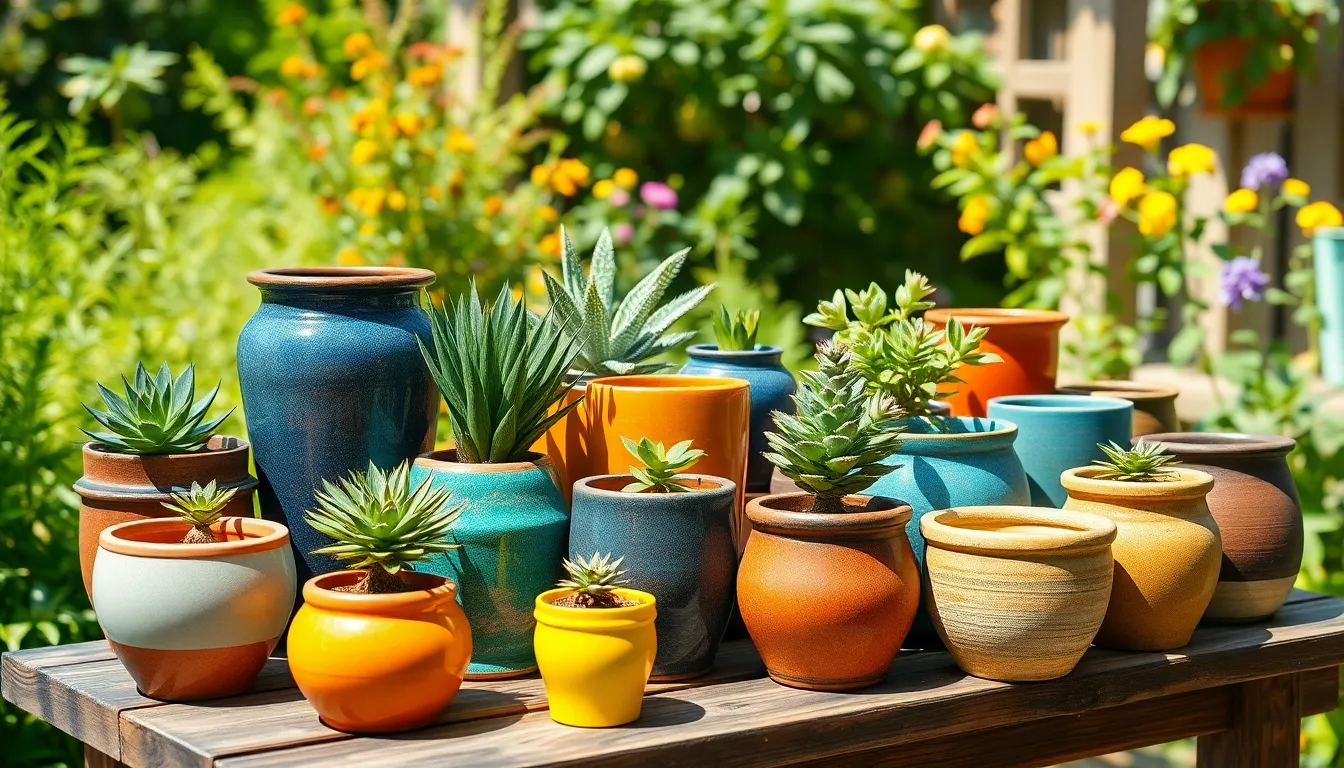
Proper maintenance extends the life of ceramic pots while keeping plants healthy. We’ll explore essential care practices that protect your investment and maintain the beauty of your ceramic planters.
Cleaning and Sanitizing Methods
Water and vinegar answers effectively remove mineral buildup and grime from ceramic surfaces. Mix equal parts white vinegar and water, then scrub gently with a soft cloth or sponge to avoid damaging the protective glaze.
Mild soap with warm water creates the ideal cleaning mixture for regular maintenance. Apply the solution using a soft brush, focusing on areas with stubborn stains or algae growth that can compromise both appearance and plant health.
Sanitizing regularly prevents pest and disease transfer between plants while protecting ceramic surfaces from mold damage. Clean pots thoroughly before repotting or storing to eliminate harmful microorganisms that could affect future plantings.
Avoid harsh chemicals and abrasive cleaning tools that can scratch or damage ceramic glazes. High pressure cleaners and rough scrubbing pads remove protective surface layers, making pots more susceptible to staining and water damage.
Preventing Cracks and Damage
Temperature fluctuations cause ceramic to expand and contract, leading to stress fractures and cracks. Bring outdoor ceramic pots indoors during freezing weather or cover them with protective materials to prevent frost damage.
Proper drainage prevents water accumulation that weakens ceramic over time. Use saucers under pots and ensure adequate drainage holes to avoid waterlogging that can cause both root rot and structural damage to the pot.
Gentle handling protects ceramic pots from chips and cracks during moving or repotting. These fragile containers require careful transport and placement to maintain their structural integrity and aesthetic appeal.
Plastic liners provide waterproof protection inside ceramic pots, preventing mineral deposits and water damage to surfaces below. These protective barriers allow root access to water while reducing direct moisture contact with ceramic walls.
Seasonal Care Requirements
Spring inspections help identify winter damage before the growing season begins. Check for cracks, chips, or glaze damage, then clean pots thoroughly and apply fresh sealants to boost durability and antimicrobial protection.
Summer monitoring becomes crucial as ceramic’s porous nature causes rapid moisture loss in hot weather. Water plants appropriately while ensuring good drainage to protect both plant health and pot integrity during peak growing season.
Fall preparation involves thorough cleaning before storage or winter protection. Remove all soil and debris, sanitize pots completely, and apply maintenance oil to darker ceramic varieties to deepen color and provide additional weather protection.
Winter protection requires bringing delicate pots indoors or covering them to prevent freeze damage. Use protective liners and maintenance treatments to help ceramic withstand harsh conditions while maintaining appearance and functionality.
Common Mistakes When Using Ceramic Pots for Plants
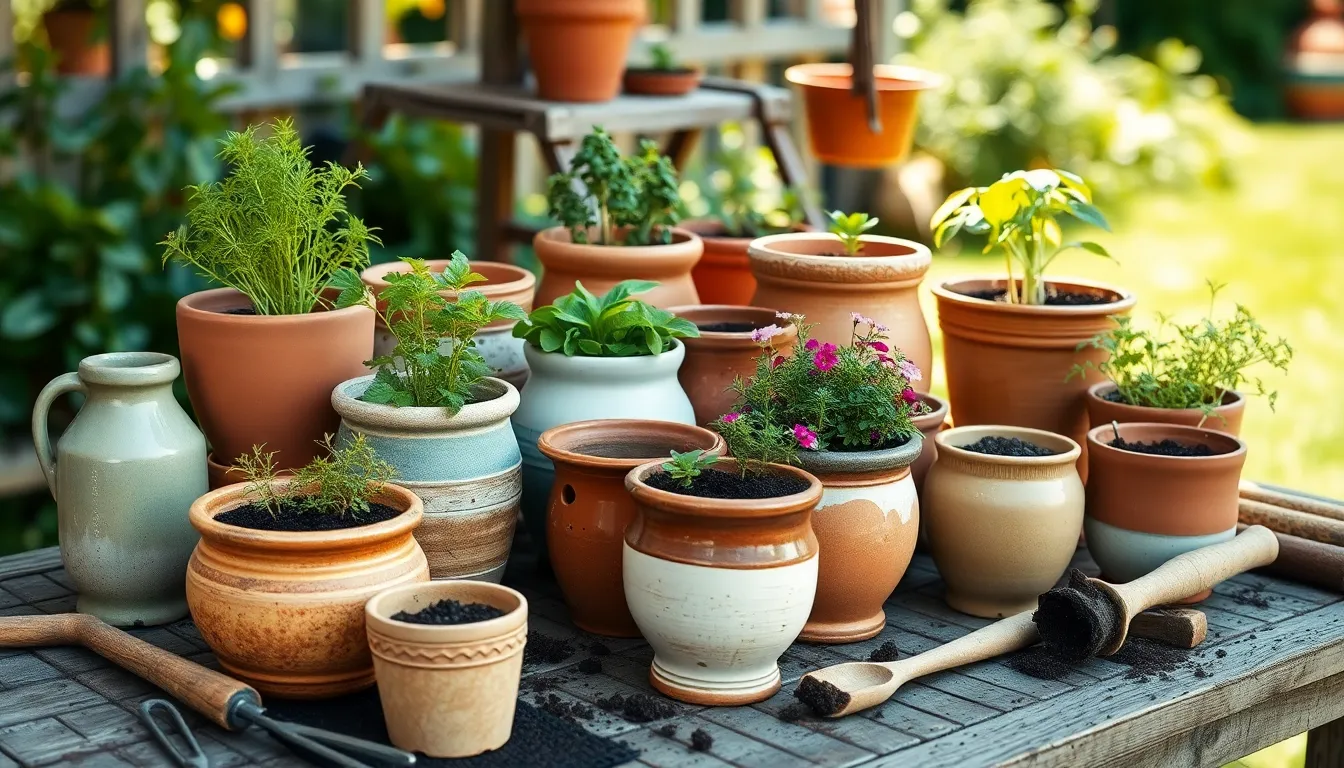
Even experienced gardeners can stumble when it comes to ceramic pot usage. Understanding these pitfalls helps us create healthier growing environments for our plants.
Overwatering Issues
Overwatering becomes a major concern with ceramic pots due to their unique moisture properties. Unglazed terracotta absorbs moisture from soil and releases it through evaporation, causing soil to dry faster than expected. We often compensate by watering more frequently, creating a cycle that leads to waterlogged conditions.
Excess water trapped in ceramic pots creates perfect conditions for root rot and fungal problems. Poor drainage compounds this issue, making it difficult for plants to recover from moisture stress. Monitoring soil moisture levels regularly helps us maintain the delicate balance these pots require.
Balancing watering schedules proves crucial for plant health in ceramic containers. Plants that prefer drier conditions thrive in unglazed ceramic, while moisture loving species need careful attention to prevent dehydration.
Incorrect Pot Sizing
Choosing pots that are too small restricts root growth and leads to stunted plant development. Cramped roots can’t absorb nutrients effectively, causing visible stress in leaves and stems. We recommend selecting pots that provide adequate space for future growth.
Oversized pots create the opposite problem by holding excess water around root systems. Large volumes of soil retain moisture longer, increasing the risk of root rot in plants that prefer well draining conditions. This common sizing mistake affects both plant health and growth patterns.
Matching ceramic pot types to plant needs ensures optimal growing conditions. Unglazed terracotta suits plants that enjoy dry, hot environments, while glazed ceramic pots work better for species requiring consistent moisture. Assessing current plant size and growth potential guides us toward appropriate pot dimensions.
Inadequate Drainage Setup
Proper drainage ranks as the most critical factor when using ceramic pots for plant health. Pots without drainage holes cause water accumulation, creating waterlogged soil conditions that damage root systems. This fundamental oversight leads to plant failure more than any other ceramic pot mistake.
Creating effective drainage requires either selecting pots with pre existing holes or adding them ourselves. The best practice involves choosing ceramic containers with adequate drainage openings from the start. When modification isn’t possible, adding a gravel layer at the bottom helps excess water escape.
Preventing moisture related problems through proper drainage promotes healthy root development. Well draining ceramic pots allow air circulation around roots while maintaining appropriate soil moisture levels. This setup prevents fungal diseases and root rot that commonly affect plants in poorly draining containers.
Budget-Friendly vs Premium Ceramic Pots for Plants
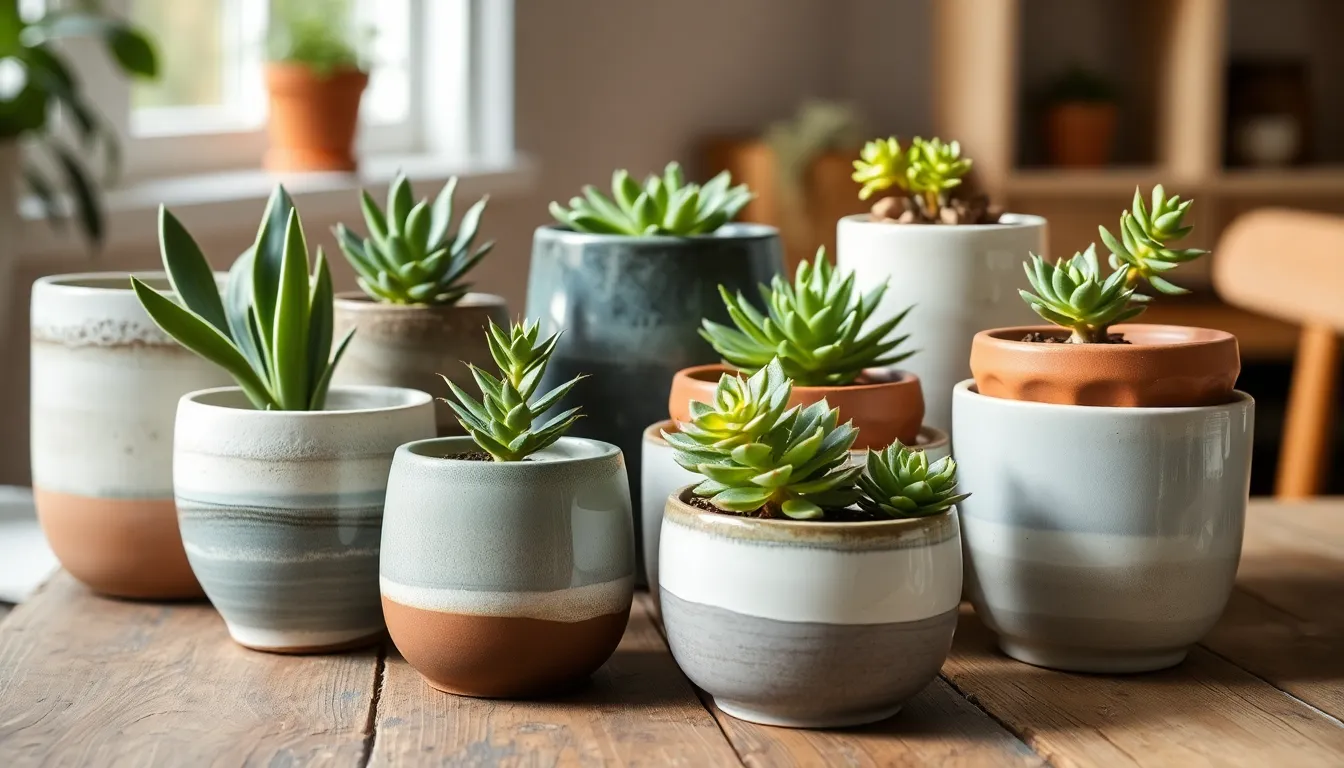
We’ll explore the different price categories of ceramic pots to help you find the perfect balance between quality and cost for your plant collection.
Affordable Options Under $20
Budget-friendly ceramic pots deliver excellent value for gardeners starting their plant journey or those needing multiple containers. These pots typically measure small to medium in size and feature simple designs with basic glazing options. Mass-produced construction keeps costs low while maintaining the fundamental benefits of ceramic materials like moisture retention and durability.
Small houseplants and succulents thrive in these affordable options, making them ideal for apartment dwellers or beginners experimenting with different plant varieties. Limited glaze variety and less intricate craftsmanship characterize this price range, but the essential functionality remains intact. Practical gardeners find these pots perfect for creating cohesive displays without breaking the budget.
Drainage capabilities in budget ceramic pots still provide adequate water management for most indoor plants. Simple color schemes and straightforward shapes make these containers easy to integrate into any home décor style.
Mid-Range Quality Choices
Mid-range ceramic pots ranging from $20 to $50 offer important improvements in construction quality and aesthetic appeal. Better glazing techniques create more vibrant colors and smoother finishes that resist fading over time. Sturdier construction methods result in increased durability and weather resistance compared to budget alternatives.
Larger sizes and varied shapes expand your planting possibilities, accommodating everything from medium-sized houseplants to small trees. Decorative elements add visual interest while maintaining functional design principles. Serious indoor gardeners appreciate this category’s balance between affordability and enhanced features.
Improved drainage design in mid-range pots often includes better hole placement and sizing for optimal water management. Enhanced weather resistance makes these containers suitable for both indoor and covered outdoor use. Longevity expectations increase significantly in this price range, making them cost-effective over time.
High-End Designer Ceramic Planters
Premium ceramic planters priced above $50 represent the pinnacle of craftsmanship and artistic design in plant containers. Hand-glazed finishes and custom treatments create unique pieces that function as statement décor elements. Artistically crafted designs feature intricate patterns, textures, and color combinations unavailable in lower price ranges.
Larger and more robust construction supports substantial plants while providing excellent protection against temperature fluctuations. Premium materials and meticulous attention to detail ensure exceptional durability that can last decades with proper care. Plant enthusiasts and interior decorators favor these containers for their visual impact and superior quality.
Temperature regulation properties in high-end ceramic pots excel at protecting plant roots from rapid environmental changes. Superior craftsmanship includes perfectly sized drainage systems and reinforced construction that prevents cracking. Investment value becomes apparent through years of reliable performance and timeless aesthetic appeal.
| Price Category | Range | Key Features | Best For | Advantages | Limitations |
|---|---|---|---|---|---|
| Budget-Friendly | Under $20 | Basic glaze, small size, simple design | Small plants, beginners | Affordable, practical | Limited design options, smaller sizes |
| Mid-Range | $20-$50 | Better glaze, varied shapes, more durable | Indoor gardeners, varied plants | Quality and cost balance | Less unique than designer options |
| High-End Designer | Above $50 | Artistic, hand-glazed, premium materials | Decorative and collector use | Unique style, exceptional durability | Higher cost investment |
Where to Buy the Best Ceramic Pots for Plants
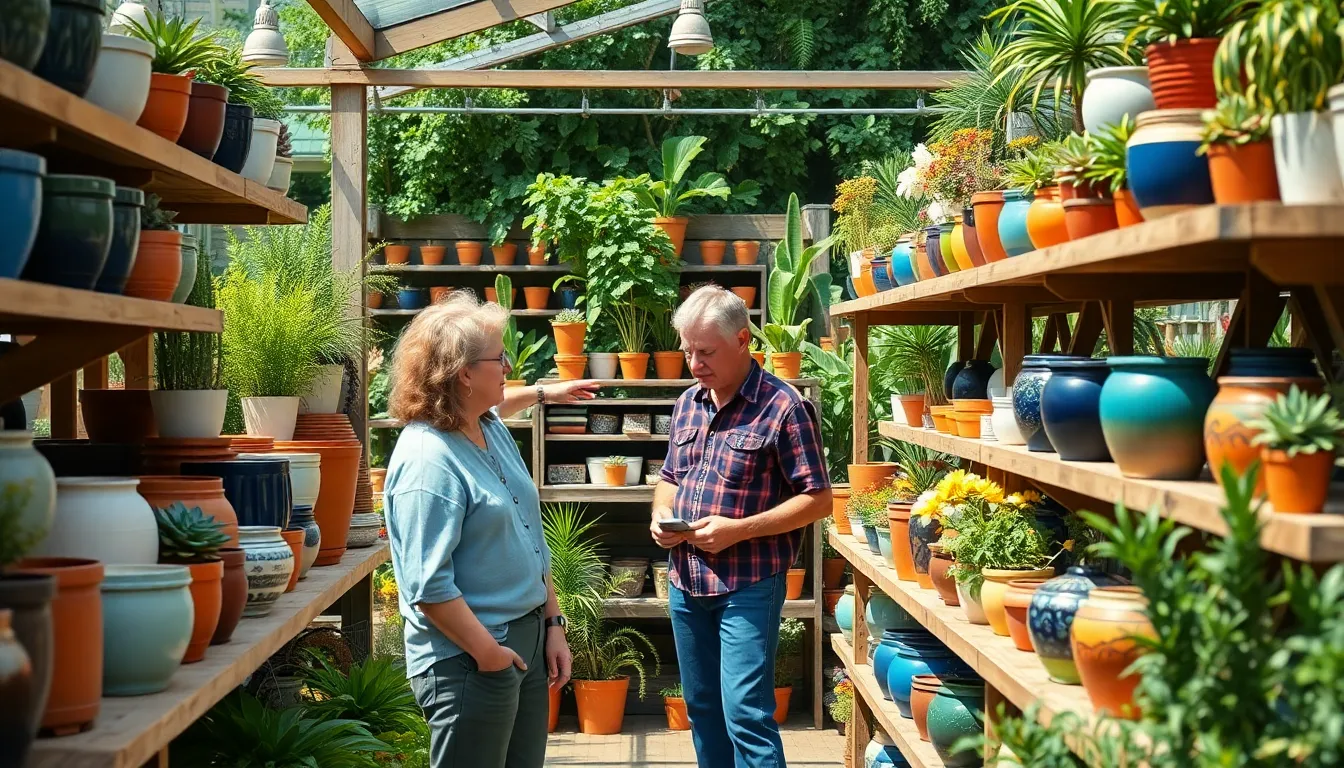
Finding the perfect ceramic pot for your plants involves knowing where to shop for quality, selection, and value. We’ve identified three primary sources that offer distinct advantages for different shopping preferences and needs.
Local Garden Centers and Nurseries
Garden centers provide the invaluable opportunity to physically inspect ceramic pots before purchasing. We can examine the quality of the ceramic material, check drainage hole placement, and assess the pot’s weight and construction firsthand. Staff members at these locations typically offer personalized advice about matching pot sizes to exact plant requirements, drawing from their expertise with local growing conditions.
Local nurseries often carry pots that are well suited to regional plant varieties and climate considerations. We benefit from seeing exactly how different glazes and finishes will look in natural lighting conditions. Many garden centers also stock ceramic pots in standard sizes that pair perfectly with the plants they sell, eliminating guesswork about proper sizing.
Online Retailers and Marketplaces
Online shopping opens access to an extensive variety of ceramic pot styles, sizes, and price points from around the industry. We can compare multiple options side by side, read detailed product descriptions, and review customer feedback about drainage performance and durability. Major online retailers often provide comprehensive care guides and sizing charts to help match pots with exact plant types.
Digital marketplaces connect us with unique artisanal ceramic pots that may not be available locally. We can find specialized features like advanced drainage systems, reactive glazes, and custom sizing options. Online retailers frequently offer bulk purchasing options and seasonal sales that make building a cohesive ceramic pot collection more affordable.
Specialty Ceramic and Pottery Shops
Ceramic studios and pottery shops offer handcrafted pieces that combine artistic design with functional plant growing features. We discover one of a kind glazes, textures, and shapes that serve as both planters and decorative art pieces. These shops often feature local artisans whose work reflects regional aesthetic traditions and high quality craftsmanship.
Specialty shops provide access to premium ceramic materials and construction techniques that enhance both durability and plant health. We can often commission custom pieces customized to exact plant requirements or interior design themes. Many pottery shops also offer classes or workshops where we can learn about ceramic properties and even create our own planters.
Conclusion
Ceramic pots represent an exceptional investment for any indoor gardening enthusiast. We’ve explored their unique combination of functionality and style that sets them apart from other planter materials.
Whether you’re selecting your first ceramic pot or expanding your collection these versatile containers offer unmatched durability and aesthetic appeal. From budget-friendly options to designer pieces there’s a ceramic pot perfect for every plant and every space in your home.
The key lies in matching the right ceramic style to your exact plants and decor needs. With proper care and maintenance your ceramic pots will provide years of reliable service while improving your indoor garden’s visual impact.
We encourage you to explore the various options available and discover how ceramic pots can transform your plant care experience into something truly rewarding.
Frequently Asked Questions
What are the main advantages of ceramic plant pots over plastic or terracotta?
Ceramic pots offer superior drainage and aeration, preventing root rot and promoting healthy root systems. They provide excellent temperature regulation, protecting plants from rapid temperature fluctuations. Additionally, high-fired ceramic is highly durable, resisting cracking and fading better than plastic or traditional terracotta, making them a long-term investment for indoor gardening.
What’s the difference between glazed and unglazed ceramic pots?
Glazed ceramic pots have a protective coating that retains moisture, making them ideal for plants that prefer consistently moist conditions. Unglazed ceramic pots offer natural porosity for excellent airflow and moisture absorption, suitable for plants that prefer drier conditions. The choice depends on your specific plant’s watering needs.
How do I choose the right size ceramic pot for my plant?
Select a pot that provides 1-2 inches of extra space around the root ball. The pot should be proportionate to your plant’s size – not too small to restrict growth, but not too large as this can lead to overwatering issues and poor root development.
How many drainage holes should a ceramic pot have?
Choose ceramic pots with at least one well-sized drainage hole to prevent waterlogging and root rot. Multiple smaller holes are often more effective than one large hole. Proper drainage is essential for preventing water accumulation and promoting healthy root development in ceramic containers.
What ceramic pot styles work best for different plant types?
Shallow ceramic pots work best for succulents, allowing quick drainage. Deep pots are essential for root vegetables that need downward growing space. Wide containers are ideal for trailing plants, providing stability and room for both root and foliage development. Match the pot style to your plant’s specific growth requirements.
How do I properly clean and maintain ceramic pots?
Clean ceramic pots using water and mild soap or a vinegar solution. Sanitize regularly to prevent pest and disease transfer between plants. Avoid extreme temperature changes, ensure proper drainage, and handle pots gently during transport to prevent cracks and damage.
What’s the typical price range for quality ceramic plant pots?
Ceramic pots range from budget-friendly options under $20 for beginners, mid-range choices ($20-$50) offering improved quality and aesthetics, to high-end designer pots above $50 featuring artistic craftsmanship and superior durability. Choose based on your budget and gardening experience level.
Where can I buy the best ceramic pots for plants?
You can purchase ceramic pots from local garden centers for hands-on inspection and expert advice, online retailers for vast selection and price comparison, or specialty ceramic shops for unique handcrafted pieces. Each option offers different advantages depending on your specific needs and preferences.

